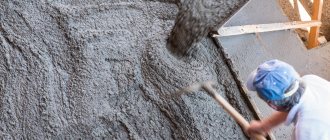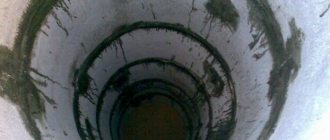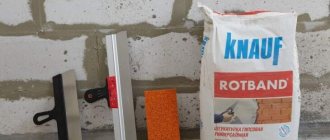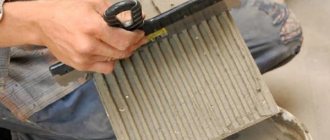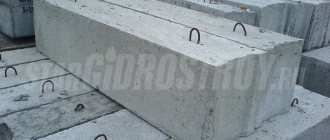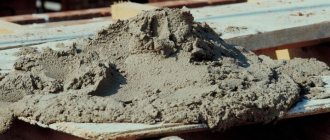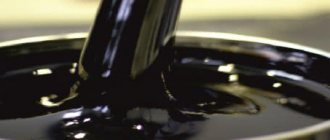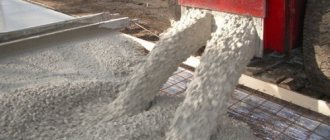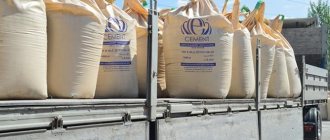Selection of bitumen mastic
Among the main factors influencing the choice of bitumen mastic, you should consider:
- durability (potential service life);
- bitumen mastic consumption per 1 m2 (layer thickness);
- the cost of mastic and the cost of roofing or waterproofing work (per 1 m2, taking into account the mastic consumption rate);
- permissible ambient temperature during work;
- place of work (external or internal sides of the premises);
- turnaround time.
Types of bitumen mastics
Bitumen mastics come in cold and hot applications, solvent-based and water-based. The physical and mechanical characteristics of bitumen mastics may look like this (see table).
Specifications
When installing a mastic roof with reinforcing fiberglass materials, you should be guided by the rule - the number of layers of mastic ≥ 3 (reinforcing gaskets made of fiberglass or fiberglass ≥ 2).
The layers of hot bitumen mastic in the roofing carpet should have a thickness of 2.0 mm, and cold - 1.0 mm.
The minimum number of layers of mastic when waterproofing the foundation is ≥ 2.
Consumption of bitumen mastic per 1 m2
One of the important characteristics of mastic is the dry residue content, i.e. the amount of substance remaining on the insulated surface after application and hardening (or drying) of fresh liquid cold mastic (solvent-based or water-based). The indicator is expressed as a percentage of the mass of the consumption of applied mastic and means that with a small dry residue, the consumption of the initial mastic increases to form a film of a given thickness.
For most mastics on the market, the dry residue ranges from 20 to 70%. To form the same coating thickness, the mastic consumption rate at 70% will be almost three times less than at 20%. This is beneficial both in terms of cost and labor intensity.
Durability
Durability is the potential maintenance-free service life of a roofing or waterproofing coating.
Flexibility and elasticity
A parameter of important practical importance is the flexibility of the material at subzero temperatures, which is assessed as tensile strength at minimum temperature. This parameter shows how elastic the material remains when strongly cooled and actually confirms the lower limit of the operating temperature range. Flexibility (frost resistance) is determined by comparing two quantities: the radius of the beam on which the tests are carried out and temperature.
The minimum temperature at which a material, when bent, remains flexible and does not crack is the flexibility temperature.
The deformability of the material (relative elongation) is accepted as the main performance indicator, therefore, the crack resistance, and, consequently, the waterproofness of the waterproofing depends on this.
Strength of adhesion to the base
A waterproofing coating with high adhesion to the base becomes more durable, does not delaminate or crack.
Flexibility, elasticity, and strength of adhesion to the base (adhesion) are the main quality indicators of bitumen mastic.
*when tested for exposure to ultraviolet rays, heat, water and frost, changes in the flexibility index of material samples are determined under cyclic exposure to atmospheric factors; at the same time, the potential service life of the material is determined by the change in the flexibility of the material up to the maximum value of this indicator, equal to 10.15 °C. This limit was adopted from the condition of practical loss of performance for roofs that have adhesive bituminous compositions with flexibility at +15 ° C, and such flexibility was established during natural examinations on collapsed roofs.
**the issue of waterproofing durability is discussed in more detail on the selection of waterproofing (see the roll waterproofing section).
It should also be noted that many manufacturers do not provide detailed characteristics of the materials they produce (at best, they refer to GOST).
These materials, as a rule, have low quality indicators and a short service life.
The most durable and reliable are coatings made from bitumen-polymer mastics (with high and detailed quality indicators).
When choosing bitumen-polymer mastics, you should focus primarily on quality, not price, and give preference to highly modified mastics, the performance characteristics and service life of which are much higher than those of low-modified ones. Cheap materials have low resistance to negative temperatures, as a result of which waterproofing can fail at an early stage of operation and even during construction.
Cost of mastic
Solvent-free bitumen mastic (hot bitumen mastic) has a great advantage in terms of material consumption. It forms a layer that does not decrease in thickness after curing. Such mastic is said to be non-shrinkable. In some designs, this indicator can play an important role when choosing a material.
Hot bitumen mastic is most often characterized by the lowest price per square meter.
The disadvantage of this type of mastic is the need to use heating equipment to convert the mastic into a liquid mass.
Work location
Water-based mastic does not contain solvents, has a neutral odor and is ideal for indoor use.
Turnaround time
A mechanized method of applying (sprayed waterproofing) a two-component bitumen-polymer composition (“liquid rubber”), consisting of a bitumen-polymer emulsion (composition 1) and a hardener (composition 2), is used when it is necessary to carry out work on large areas in a short period of time time.
What are bitumen mastics
The base material itself is waterproof, which determines its use for waterproofing various structures. The most effective means of combating moisture is bitumen-based mastic, produced by the manufacturer TechnoNIKOL for a wide variety of applications, especially for waterproofing foundations and roofs of buildings.
The need for a material per m2 depends on several factors, including its composition, consistency, means for application to the surface, as well as the conditions of use.
Various waterproofing compositions have been developed for use according to the nature of the surface to be protected and operating conditions:
- mineralized compositions with fillers from ash, chalk, and other similar materials;
- emulsion mixtures having a water base with the addition of fine dust from bitumen;
- polymer-containing mastics using rubber crumbs, polyurethane or polystyrene fillers, as well as mineralized additives;
- compositions with sealing properties, including petroleum bitumen, mineralizers and plasticizers. Area of application: instrumentation and radio electronics for insulating units, their components, and radio device sockets.
Mastic is available both in diluted liquid form and in a hardened state. The method of application, as well as the consumption of the substance per 1 m2 of object, is always indicated on the product packaging. The material is also divided into products used in hot and cold conditions. Hot application mastic is preheated to a temperature of about 170°C. You should know that the heated material hardens in 1 - 2 minutes, as a result of which its surface forms a hardened, durable film that protects the coated surface from moisture. It is important to remember that bitumen insulating materials with synthetic fillers are not used indoors due to possible toxic fumes.
What is the consumption of mastic for waterproofing the foundation?
In order to waterproof concrete structures and protect them from other harmful external factors, it is recommended to treat surfaces with special means. The most important property of such waterproofing compounds is resistance to moisture. The most effective among them is bitumen waterproofing mastic, most often used to protect foundations and roofing.
Before finding out its consumption for waterproofing the foundation, we suggest that you first familiarize yourself with their varieties, properties and find out the standard consumption for different types of bitumen lubricant. This information is presented below, as well as the norms per 1 m² of treated base.
Waterproofing the foundation with mastic is an expense.
For this work, all main types of bitumen mastics can be used. However, their consumption rates are somewhat different. Cold application mastics are consumed in a volume of 1-1.5 kg per 1 m2 , provided that the thickness of one layer is about 0.5-1 mm . Consumption increases proportionally with increasing number of layers.
Hot mastics, due to technological difficulties, are applied in a thicker layer - 2 mm. Therefore, the consumption of raw materials, accordingly, increases and amounts to 2 kg per 1 m2 . It is worth considering that the number of layers when waterproofing a foundation cannot be less than two, that is, the consumption must be at least doubled.
Aquamast bitumen mastic for foundation waterproofing - consumption.
Another type is TechnoNIKOL - bitumen-rubber mixture AquaMast. It is used not for external, but for internal waterproofing of premises, for example, for treating bathrooms. Its consumption varies from 0.5 to 1.5 kg per 1 m2 .
Standard consumption of the product for different application methods.
Depending on the type of bitumen mixture, the standard cost also changes. Hot compositions do not shrink, that is, they do not change thickness during the application process. The average consumption of mastic agents when gluing two surfaces is 0.8-1 kg per m² of area. For waterproofing purposes, approximately 2-3 kg are used to provide a layer 1 mm thick.
If the substance is applied in a layer of up to 2 mm, then we get the so-called dry residue - the substance that remains after drying on the surface. In this case, the consumption will be from 3.5 to 3.8 kg per square meter.
Technical characteristics vary depending on the type of product; accordingly, the consumption parameters also differ.
In order to waterproof roof slabs, a layer of bitumen mixture is applied 2 mm thick for the hot type and 1 mm thick for the cold type. For the foundation, everything doubles, since 2 layers are already applied.
When assessing the conditions for foundation waterproofing, builders are guided by the following data (averaged, may differ from one manufacturer to another):
Types of bitumen mastics, their features.
This mixture is recommended for waterproofing foundations, roofs, and various metal pipes. Proper waterproofing prevents moisture from penetrating the reinforcement of concrete products. For this purpose, special formulations are used, which differ in the method of use. They may contain various additives and components that reinforce, allow the mastic to be used on a wet surface, and increase resistance to corrosion.
Additional components in the mixture increase the durability of the building. If the house is small, then such additives may not be used. But large objects have this disadvantage: after a few years, groundwater can leak through pores in the concrete foundation to the reinforcement of the house frame.
Such support of the building will be disrupted and the load on the foundation will increase significantly. To avoid this, it is better to use waterproofing, which contains special reinforcing components - they not only create protection against moisture penetration, but also increase strength.
For waterproofing, 2 main types of mastics are used, differing in method of use:
Hot method.
Application requires preheating of the material. This mixture is applied only when hot, and after hardening it acquires a monolithic coating. This application method requires the use of additional equipment, so its use is not very popular.
Cold way.
It's more simple. Before use, this mixture only needs to be mixed, after which it can be applied to the prepared surface. A separate group of cold-applied mixtures has a long shelf life. But this group also has its own characteristics: before use, you need to combine and mix several components that are stored in different containers. Cold-use mastic is also divided into a water-based mixture and a solvent-based mixture.
Advantages of bitumen-based products.
The versatility of the products is confirmed by the numerous positive properties of the mastic:
- Creating a waterproofing film over the base being treated, which prevents moisture from seeping through.
- Clogging of possible small defects on the base and surface pores with bitumen grease.
- Creating an obstacle to the development of fungus and mold on the base.
- High adhesive properties in relation to any building materials.
- Frost resistance of TechnoNIKOL bitumen products.
- Elasticity and no cracking.
Recommendations for selection.
- Average consumption per 1 m2, taking into account the thickness of the applied layer and their number recommended by the manufacturer.
- The durability of the resulting coating, its compatibility with other building materials for insulation.
- Permissible air temperature at the time of application.
- Location: For interior basements or exterior foundation walls, both universal and specialized types are used.
- Required deadlines.
- Cost of mastic and primer (taken into account along with consumption indicators).
- Application method: when working with large volumes, a sprayer and mixtures with latex additives are used.
Consumption of bitumen mastic per 1 m2 of waterproofing
It is clear that the amount of substance consumed directly depends on its type. Less is wasted when hot, since it spreads faster and does not dry out, that is, after cooling, the thickness of the layer remains unchanged. On average, for a millimeter thickness you will need about 3 kg. If bitumen is used for gluing, then the consumption is reduced threefold - to 1 kg per 1 m2 of area.
When doubling, you will need about 4 kg per square, and the volume of dry residue increases in proportion to this.
To insulate the roof, a 2 mm layer of hot compound and 1 mm of cold compound is sufficient. For the foundation and basement - 4 mm hot and 2 mm cold, but the solution is applied in 2 layers.
Consumption table
| Standards | Cold with solvent | Cold on water emulsion | hot | |||
| roof | foundation | roof | foundation | roof | foundation | |
| Layer thickness, mm | 1 | 0,5-1 | 1 | 0,5-1 | 2 | 2 |
| Consumption, kg/sq.m | 1-2 | 1-1,5 | 1,5-2 | 1-1,5 | 2 | 2 |
| Hardening time, hours at 20°C | Day | Day | 5-7 | 5-7 | 4-5 | 4-5 |
| Application temperature, °C | -10…+40 | -10…+40 | +5…+30 | +5…+30 | from -10 and above | from -10 and above |
| Permissible surface humidity, % | 4 | 4 | 8 | 8 | 4 | 4 |
How to calculate the amount of TechnoNIKOL mastic
The company's main product line is presented in ready-made form. Supplied in hermetically sealed containers of various sizes and purposes. Among the main additives:
- crumb rubber;
- polyurethane;
- polystyrene;
- mineral supplements;
- organic solvents.
It is through the precise calculation of combinations that the high adhesive properties of the primer and its resistance to critical temperature peaks are determined.
The average consumption for waterproofing 1 m² per 1 mm layer is 3-3.5 kg, for gluing two surfaces - up to 1 kg.
Department 2. PROTECTION OF BUILDING STRUCTURES AND EQUIPMENT FROM CORROSION
1. General instructions
1.1.
This collection includes construction processes for waterproofing walls, foundations, supports and spans of bridges and overpasses, anti-corrosion protection of above-ground and underground reinforced concrete and metal structures, wastewater treatment plants, deep underground tunnels, etc. from new types of mastics and weld-on rolled materials.
The collection consists of sections:
section 01 - installation of coating waterproofing;
section 02 - installation of adhesive waterproofing from welded roll materials;
section 03 - installation of plaster waterproofing.
1.2.
This collection was developed on the basis of technical conditions and instructions for the use of mastics and weld-on roll materials, a catalog of works and materials for special protection of building structures, SNiP 3.04.01-87 “Insulation and finishing works”, SNiP 2.03.11-85 “Protection of building structures from corrosion", SNiP 3.04.03-85 "Protection of building structures and structures from corrosion".
1.3.
Standard indicators of material consumption are intended to determine the need for materials during insulation work.
1.4.
The standards take into account the net consumption and hard-to-remove losses (waste) of materials generated within the construction site when performing work operations provided for by the technology of work (in accordance with RDS 82-202-96 and its amendments).
1.5.
The standards for the consumption of materials for waterproofing building structures are determined by the calculation and analytical method using regulatory and methodological documentation, work technology and the properties of standardized materials, SNiP.
1.6.
Before applying a waterproofing layer, the surface of building structures must be dry, dust-free, grease-free, and free from holes, cracks and other defects.
1.7.
Priming with a primer before applying the main layer of mastic to the insulated surface is not required; only if it is impossible to remove grease stains, priming of the bases with appropriate compounds is used.
1.8.
The thickness of the layer of applied mastic cannot be less than 1 mm, the minimum number of layers is 2. The exception is polyisobutylene mastic MP, applied at a time with a layer thickness of 0.6 mm.
Anti-corrosion protection in highly aggressive environments must have a coating thickness of at least 4-5 mm.
1.9.
When applying Germokrov and Biturel mastics to inclined and vertical surfaces, it is necessary to add the Germogust thickener to them before use: in Germokrov - up to 20%, in Biturel - up to 30% of the mass of the mastic composition.
1.10.
When installing waterproofing from fused rolled materials, it is necessary to prime the surface with a primer. Depending on the type of welded roll material used, the primer composition is prepared in the following ratios:
for filisol and elastobit:
bitumen BN 90/10 - 1 hour;
solvent - 3 hours;
bitumen BN 90/10 - 1 hour;
solvent - 2 hours.
1.11.
When gluing waterproofing layers on vertical and inclined (more than 25°) surfaces, sheets of rolled material 1.5 - 2 m long are used. If the insulated surface is of a significant height, the roll material is applied in tiers, starting from the bottom, with an overlap of 100 mm. To secure the waterproofing layers on each tier, antiseptic slats are installed every 1.5 - 2 m in height, which are secured with construction nails at intervals of 200 mm.
1.12.
In places of transition from horizontal to vertical surfaces, transitional inclined sides made of concrete are installed at an angle of 45°. Waterproofing layers of rolled material are brought from a horizontal surface onto a vertical surface through inclined sides and covered with insulating layers on a vertical surface. The amount of overlap must be at least 250 mm in both directions.
1.13.
When installing plaster waterproofing using Kalmatron protective composition, the thickness of the applied layer depends on the surface quality of the structural element:
even and smooth - 3 mm;
if there are a large number of cracks, cavities, and irregularities - 5 mm.
1.14.
Material consumption standards for waterproofing capacitive structures, all types of tunnels, basement walls, etc. take into account the consumption of waterproof sand concrete with increased corrosion resistance from prestressed cement NTs with a total thickness of the applied layer of 30 mm using the shotcrete method.
For other layer thicknesses and methods of applying sand concrete (manually, by pneumatic spray), the consumption rates are subject to adjustment.
1.15.
When installing waterproofing from the waterproofing compound “Dichtugsschlemme”, the thickness of the applied layer depends on its purpose.
When installing waterproofing against ground moisture and seeping water, the layer thickness is 2 mm;
with surface moisture and low-pressure water - 2.5 mm;
with a water pressure of 1 m - 3.5 mm;
with water pressure St. 1 m - 4.5 mm.
The waterproofing layer is applied from the water pressure side. Depending on the thickness of the layer - with a hand brush or a combined notched-trowel or spray.
To apply a layer of the required thickness, the waterproofing mixture is diluted with water to the desired consistency.
1.16.
The consumption rate of the rubber-bitumen emulsion “Flechendicht” depends on the structure and hygroscopicity of the base. The minimum number of layers is two for a rigid base, for porous bases - three. In damp and damp places, waterproofing is first applied to the joints of walls and floors, pressing into the base, then onto the entire surface.
2. Rules for calculating the volume of work
2.1.
The scope of work on the installation of waterproofing coatings should be determined by the design area of the insulated surface.
Standard indicators of specific consumption
Mastic consumption for 1 m2 depends on the form of application - hot or cold. When using TechnoNIKOL hot mastic for waterproofing, you need to take into account that it is non-shrinking and the thickness of the applied layer does not change when drying. If it was 2 mm, then it will remain so.
When gluing roofing materials, the consumption of TechnoNIKOL material will be about 0.8 - 1.0 kg/m2, and when installing waterproofing, 2.0 - 3.0 kg will be required with a layer thickness of 2 mm.
To apply a layer of waterproofing of this thickness, 3.5 - 3.8 kg of material in dry matter will be required. This indicator indicates the amount of TechnoNIKOL material in the layer after it has dried, thus it is possible to determine the consumption of the initial mass per m2 to obtain a layer of a certain thickness. Obviously, when using mastic with a 20% solids content, you will have to spend 3 times more than for 70%. The data is important for determining quantities when purchasing material. Table 1 shows some data typical for TechnoNIKOL mastic:
| Characteristics | Indicators | |||||
| Cold use on synthetics | Cold application on water | Hot application | ||||
| On the roof | On the foundation | On the roof | On the foundation | On the roof | On the foundation | |
| Thickness at 1 mm layer | Up to 1 | 0,6 – 1,0 | Up to 1 | 0,6 – 1,0 | 2,0 | |
| Consumption rate in kg/m2 | 1,0 – 2 | 1,0 – 1,5 | 1,5 – 2 | 1,0 – 1,5 | 2,0 | |
| Drying time at 20°C and humidity up to 50%, hour | 24 | 5 | 4 | |||
| Permissible operating temperature, оС | -10 — +40 | +5 — +30 | To 10 | |||
| Indicator of permissible surface humidity, % | 4 | 8 | 4 | |||
When calculating the need, the specific consumption for m2 must be multiplied by the number of waterproofing layers of the treated surface:
- For roof waterproofing using fiberglass materials, the number of layers is at least 3 (if a 2-layer installation of fiberglass is installed).
- The thickness of the layer of hot mastic for roofing is at least 2 mm, cold - more than 1 mm.
- Foundation waterproofing must consist of at least two layers.
Properties of bitumen-based compositions
Bituminous waterproofing mastic is a moisture-resistant material. It is mainly used to protect concrete from the negative effects of moisture. Using this mixture, you can waterproof not only the foundation, but also the roof.
The main properties of this bitumen-based product include:
- stability when exposed to negative environmental factors - ultraviolet radiation, moisture, oxidizing agents;
- light weight;
- elasticity;
- sufficient strength;
- anti-corrosion qualities;
- moisture resistance;
- long service life.
In many ways, the properties of bitumen mastics depend on their composition. Often their main components are organic components with high astringent properties, antiseptics, mineral fillers and other additives. In appearance they are a dark viscous liquid. As it hardens, it becomes hard and dense.
Features of application
Bitumen lubricant is usually divided into two main types - cold and hot. The first type is a completely ready-to-use product. It contains a volatile solvent that evaporates quickly in open air. Therefore, after applying this composition, it quickly hardens, forming a monolithic film that is resistant to external influences.
Hot mixture requires heating immediately before use. At first it is solid, but after reaching a certain temperature it becomes liquid. The consumption of each type of material is determined individually, which is explained by different surface treatment technologies.
Bitumen mastic. Peculiarities
This type of material is indispensable for construction work. Due to component differences, bitumen coating is used:
- As a waterproofing material;
- For the production of certain building materials;
- For processing pipes that are located primarily underground.
More details about each type of application below.
Application
This material is especially good as waterproofing. All structures, pipelines, foundation structures that have any contact with the ground or are submerged underground will be perfectly protected by mastic from soil moisture, precipitation, sprouting grass, as well as mold and much more. Bitumen coating protects against corrosion and erosion formations.
The adhesive function of mastic allows you to glue different surfaces. This is her undeniable advantage. You can glue, for example, sand-lime brick and tiles.
When repairing roads, bitumen coating is also irreplaceable. It is heated to a certain temperature until all the moisture from the mixture has evaporated.
Next, small fractions are added, for example, stone chips. Liquid bitumen can be used:
- For filling small road holes;
- Fill cracks;
- Make stitches.
Kinds
Coating materials can be divided according to the following criteria:
- Application technologies;
- Composition;
- The base used;
- Number of components;
- States.
Bitumen coating is applied in one of two ways:
- Hot application;
- Cold application.
Hot application of a substance requires professionalism, certain knowledge and skills. Coating materials can also be divided depending on the temperature to which a particular material needs to be heated.
It is worth noting that bitumen mastic can be used as an independent coating or as an adhesive for roll waterproofing.
Cold application of the material is ensured immediately without prior preparation. At very low temperatures, the polymer still needs to be slightly warmed up so that it becomes more elastic and fits well on the concrete surface.
Based on their composition, mastic substances are divided into the following types:
- Mineral based. Waterproofing includes chalk, limestone, asbestos and other minerals. In addition to them, the composition includes a plasticizer, which increases the adhesion of the mastic substance.
- "Rubber" compounds. This includes: rubber or fine rubber powder, bitumen, plasticizers.
- Rubber compound.
Due to the fact that rubber is one of the components of mastic, it acquires even more advantages:
- increased elasticity;
- reliability;
- high density;
- double protection against moisture.
To improve adhesion to the concrete surface, the concrete is first moistened. It is also worth noting that latex mastics can be classified as rubber mastics, since latex is an improved rubber formula. Latex compounds can be used to treat foundations even at very low temperatures without preheating.
Polymer compositions. They dry faster than the previous coating option - up to 8 hours, rubber - up to 12 hours.
It is worth noting that the drying speed depends on:
- weather conditions;
- number of layers applied;
- the structure of the surface on which the composition is applied.
It is important to say that polymer coating can protect against radiation.
Oil coating. It tolerates frost and temperature changes well.
A bitumen-mastic substance, diluted with a solvent or water, turns into a bitumen primer. It acts as a kind of “primer” for the foundation. After the primer has dried, layer after layer of mastic is applied.
The base for bitumen mastic can be:
- Water;
- Organic solvent.
The data is indicated in the composition on the packages. This suggests that mastic based on organic compounds cannot be diluted with water and, vice versa.
As for the number of components, they are:
- One-component compositions. They are immediately ready for use.
- Two-component mixtures are mixed in the required proportions in a special container. Application must be done immediately.
After applying one or another type of coating material, it begins to set on the surface of the foundation, dry out and form a protective layer. The coating can become completely solid, or dry out but remain semi-solid.
Specifications
The technical characteristics of bitumen coating include the following:
- Conditional strength. It is measured in megapascals (MPa). This unit shows pressure and tension.
- Adhesion strength to concrete (MPa).
- Elongation at break (%). As a rule, the elongation should be at least 100%.
- Water absorption per day (%). The optimal value of the indicator is no more than 1%.
- Conditional viscosity. Measured in seconds.
- Mass fraction of non-volatile substances (%).
- The temperature that causes the material to soften must be at least 100 degrees.
Advantages
Bitumen-mastic material has many advantages. Here they are:
- High adhesion rates. Thanks to them, bitumen mastic tightly and reliably envelops the foundation (it even penetrates microcracks), which eliminates the possibility of moisture penetrating under the material. This, in turn, helps avoid rust that can attack the metal bars of the foundation structure.
- If bitumen coating is applied soon after the foundation is erected, its performance properties are not lost. Mastic “can adapt” to the displacement of buildings and remain intact.
- No life forms can develop on the surface of bitumen mastic.
- Bituminous mastic can be applied even by an amateur who is encountering it for the first time. The application technology is simple and does not require special knowledge and skills. In addition, applying waterproofing material does not require much time.
- The performance of the mastic can be increased if, for example, roll materials are also used for waterproofing.
- Weather conditions have virtually no effect on the possibility of treating the foundation with mastic. This is another undeniable advantage.
- It is also worth noting that the material has a fairly low cost, and, therefore, is the most affordable compared to others.
When choosing a mastic coating, you need to pay attention to the price, which should be acceptable. The quality of application, polymerization and performance properties of the substance depend on this. It also happens that the mastic quickly cracks after application, or is poorly applied, does not adhere to the surface, and so on.
Also, this waterproofing material takes a long time to dry, so it is better to continue further work on the construction of the house after the layer has completely dried.
Standard consumption for different methods of applying a waterproofing product
The consumption of bitumen mastic per 1 m2 is determined by its type and method of application to the surface. It should be understood that hot mixtures do not shrink after processing and during the cooling process. Therefore, they do not change their thickness. When gluing surfaces, the average consumption of bitumen-based mastic is 800–1000 g per square meter of area.
To increase the waterproofing properties of a certain structure, a layer of at least 1 mm thick is applied to it. This corresponds to a consumption of 2–3 kg per 1 sq. m. If it is necessary to apply a layer 2 mm thick to the surface, after drying a special substance called “dry residue” is formed. Therefore, the mastic consumption will be about 3.5–3.8 kg per 1 sq. m. m.
If the roof is waterproofed, the material is used in a different quantity. If it is cold mastic, the consumption will be 1–2 kg/m2, hot - 2 kg/m2.
Types of bitumen mastic
Depending on the application option and the chemical base, there are 3 types of seamless insulating mixture:
- Bitumen mastic based on aggressive reagents for distribution without heating. This version of mastic does not harden due to the chemical reagents in the composition. But when applied manually, hazardous fumes are released, so you need to protect your skin, eyes and lungs from toxic fumes.
- Bitumen mastic for application without heating based on water emulsion. It also contains synthetic components, but only water-soluble ones. Therefore, the composition is more environmentally friendly. But there is a limitation in the application temperature. Its limits are from +5 to +30˚С.
- Hot applied bitumen mastic. To work with it you need special equipment and experience. Before the composition acquires a liquid state, it must be heated to 90˚C. If handled carelessly, there is a risk of burns.
View this post on Instagram
Posted by Ecomast (@ecomast_official) Jun 1, 2020 at 1:45 PDT
How to calculate the required amount of waterproofing mixture
The consumption of bitumen mastic depends on the method of its application - cold or hot. This indicator is influenced by the type of surface being processed and the requirements for the final result of the work. The type of work being carried out must be taken into account - gluing surfaces or waterproofing. In the first case, the consumption is always less than in the second.
Experts recommend paying attention to the dry residue. Its value ranges from 20 to 70%. At a minimum rate, consumption increases significantly, and vice versa. Therefore, it is recommended to select materials with a large dry residue, which reduces the labor intensity of their application.
To calculate the consumption of bitumen mastic for treating a specific surface, you must use the instructions presented below.
For example, we consider a situation where the material is applied in one layer 1 mm thick over an area of 5x5 m:
- The coating area is calculated - 5x5 = 25 square meters. m.
- Using special tables, the standard consumption of waterproofing compounds per 1 m 2 is determined. Cold – 2000 g, hot – 3000 g.
- We perform simple calculations: 25x2=50 kg or 25x3=75 kg.
- If it is necessary to perform processing in two layers, the amount of materials is doubled: 50x2=100 kg, 75x2=150 kg.
Bitumen consumption rates for waterproofing: bitumen consumption per 1m2
Depending on the nature of the work, you can approximately calculate the consumption of bitumen mastic per 1 m2. So, if you need to create an adhesive layer to fix the building coating, you will need 1 layer of 0.5–0.9 mm. This requires approximately 0.8–2.5 kg per 1 m2.
When waterproofing a foundation, 1–1.5 kg of cold mortar covering 1 m2 of area with a thickness of up to 1 mm will be needed. If the coating is in several layers, the volume of insulation will increase.
For hot application, a thickness of 2 mm is required. Therefore, the volume of required mass per 1 m2 is approximately 1.5–2 kg.
The table shows approximate standards for individual brands declared by the manufacturer:
| Name | Quantity kg per 1 m2 |
| TechnoNIKOL | 0,8 |
| VIEW | 1 |
| Aquamast | 3,3–4,3 |
| Ecomast | 0,5 |
| BITUMAST | 0,5 |
| Tex | 0,5–2 |
| Izhora | 0,5–2 |
If you need to find out the volume of material for installation, you can use the following formula:
P = Pl x Nr x Ks, where P is the total flow rate. Pl – base area. Нр – consumption rate specified by the manufacturer. Ks – number of layers.
For example, you need to provide waterproofing in a 4x5 m room. The rate of mastic use is 2 kg/1 m2. Insulation is applied in 2 layers.
Volume of solution for work = 20 m2 (4x5m) multiplied by 2 kg and 2 layers = 80 kg.
In addition to horizontal application, do not forget to treat the walls to a height of 10–15 cm.
Each new layer is applied only after the previous one has completely dried.
Technologies for correct application of compositions containing bitumen
When using bitumen mastic, it is especially important to apply it correctly to the surface. The technology for performing this operation involves several successive stages:
- padding. The structure is treated with a liquefied emulsion-type paste, which creates a solid foundation for subsequent layers;
- cold or heated bitumen treatment;
- The dried waterproofing is treated with an additional layer of protection. Sand, gravel, and special paints can be used for this.
During the work process, you must carefully perform all actions and strictly follow the instructions of the material manufacturer. After opening the cans of bitumen mastic, they immediately begin to treat the surfaces. The mixture is collected using a roller or brush. Each strip of waterproofing solution should not overlap the previous one by less than 10 cm. When applying subsequent layers, you should take a break so that the mixture dries well.
Many types of mastics can be used as an adhesive base when laying insulating roll materials. If the mixture is used to cover the roof, it is allowed to paint it in a color that will match the overall design of the building. To do this, it is recommended to use paints that do not contain water.

